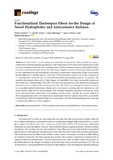Mostrar el registro sencillo del ítem
Functionalized electrospun fibers for the design of novel hydrophobic and anticorrosive surfaces
| dc.creator | Rivero Fuente, Pedro J. | es_ES |
| dc.creator | Yurrita Silanes, David | es_ES |
| dc.creator | Berlanga Labari, Carlos | es_ES |
| dc.creator | Palacio, José F. | es_ES |
| dc.creator | Rodríguez Trías, Rafael | es_ES |
| dc.date.accessioned | 2019-07-31T12:26:55Z | |
| dc.date.available | 2019-07-31T12:26:55Z | |
| dc.date.issued | 2018 | |
| dc.identifier.issn | 2079-6412 (Print) | |
| dc.identifier.issn | 2079-6412 (Electronic) | |
| dc.identifier.uri | https://hdl.handle.net/2454/33784 | |
| dc.description.abstract | In this work, a novel coating was deposited on aluminum alloy samples by using a combination of electrospinning and chemical vapor deposition (CVD-silanization) techniques in order to create a functionalized film with an enhancement of both corrosion resistance and hydrophobicity. The electrospinning technique makes the fabrication of highly crosslinked electrospun fibers possible by the combination of both poly(acrylic acid) and beta-cyclodextrin, respectively, which can be easily functionalized in a further step by using the CVD-silanization process due to the evaporation of a hydrophobic molecule such as 1H,1H,2H,2H-Perflurodecyltriethoxysilane. In addition, the resultant electrospun fibers with a high degree of insolubility have been successfully fabricated and metal oxide nanoparticles (TiO(2)NPs) have been incorporated into the electrospun polymeric solution in order to improve the corrosion protection. The surface morphology has been determined by using light optical microscopy, atomic force microscopy, scanning electron microscopy, and water contact angle (WCA) measurements. The corrosion resistance has been evaluated by using both potentiodynamic polarization and pitting corrosion tests. Finally, the results related to WCA measurements after CVD-silanization corroborate that the surfaces have been successfully functionalized with a hydrophobic behavior in comparison with the electrospinning process, showing a considerable difference in the roughness. | en |
| dc.description.sponsorship | This work was funded by the Spanish Economy and Competitiveness Ministry-FEDER Proyecto Retos (TRA2013-48603-C4-1-R) and the Public University (Navarre-PRO-UPNA18 (6107)). | en |
| dc.format.extent | 11 p. | |
| dc.format.mimetype | application/pdf | en |
| dc.language.iso | eng | en |
| dc.publisher | MDPI | en |
| dc.relation.ispartof | Coatings, 2018, 8(9), 300 | en |
| dc.rights | This is an open access article distributed under the Creative Commons Attribution License which permits unrestricted use, distribution, and reproduction in any medium, provided the original work is properly cited (CC BY 4.0). | en |
| dc.rights.uri | http://creativecommons.org/licenses/by/4.0/ | |
| dc.subject | Electrospun fibers | en |
| dc.subject | CVD | en |
| dc.subject | Functionalized surfaces | en |
| dc.subject | Hydrophobicity | en |
| dc.subject | Corrosion protection | en |
| dc.title | Functionalized electrospun fibers for the design of novel hydrophobic and anticorrosive surfaces | en |
| dc.type | info:eu-repo/semantics/article | en |
| dc.type | Artículo / Artikulua | es |
| dc.contributor.department | Ingeniería | es_ES |
| dc.contributor.department | Ingeniaritza | eu |
| dc.contributor.department | Institute for Advanced Materials and Mathematics - INAMAT2 | es_ES |
| dc.rights.accessRights | info:eu-repo/semantics/openAccess | en |
| dc.rights.accessRights | Acceso abierto / Sarbide irekia | es |
| dc.identifier.doi | 10.3390/coatings8090300 | |
| dc.relation.projectID | info:eu-repo/grantAgreement/MINECO//TRA2013-48603-C4-1-R/ES/ | en |
| dc.relation.publisherversion | https://doi.org/10.3390/coatings8090300 | |
| dc.type.version | info:eu-repo/semantics/publishedVersion | en |
| dc.type.version | Versión publicada / Argitaratu den bertsioa | es |
| dc.contributor.funder | Universidad Pública de Navarra / Nafarroako Unibertsitate Publikoa, Navarre-PRO-UPNA18 (6107) | es |



